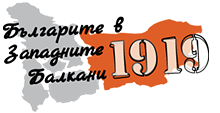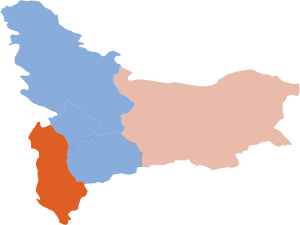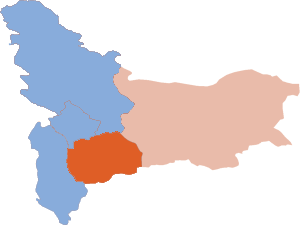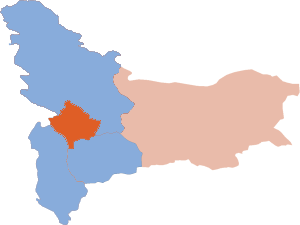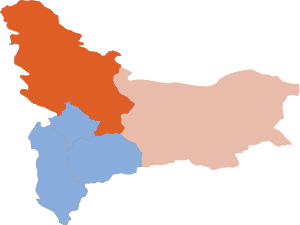The Bulgarian national liberation movement in Macedonia (1893–1912) ideology, politics, revolution
Sen. Asst. Prof. Georgi N. Georgiev, PhD
The Kresna-Razlog Uprising 1878–1879 and the Unification of the “Two Bulgarias” in 1885 were the two highlights along the journey on which embarked the all-Bulgarian revolutionary movement from the epoch of National Revival towards its “Modernity”. The first event continued the “Bulgarian uprisings” for political independency (statesmanship) from before 1878. The second one provided – again with respect to continuity – an Eastern Rumelian autonomy model and the example of the Unification to those parts of the ethnical territories remaining “under the yoke” of the Ottoman empire. The organized (conspiracy) mass national liberation struggle of the Bulgarian population in Macedonia and Adrianople region, led by IMARO, was a result of the same processes that determined the emergence, although under different circumstances, of the legal Macedonian/Macedonian-Adrianople organization in the Principality of Bulgaria. The earlier origin of the Internal Organization is only but a chronological detail owing to a single factor: the rule of Stefan Stambolov and his attitude to revolution and revolutionary conspiracies as a means of settling the Bulgarian national issue after the Congress of Berlin. The governmental concept of the former, in his young age, revolutionary apostle, considered by his admirers a Balkan copy of the “iron chancellor” Bismarck, convincingly relied on a sensible and firm, as much as possible and required, “real policy” towards the Ottoman Empire. Namely: the obtaining of greater concessions in favor of the Bulgarian element in the “vilayets” through the Exarchate – the legitimate institution that represented legally the interests of the Bulgarian Christian ethnic community – “millet”, under the rule of the Sultan-Caliph in Constantinople. To that “foreign” peculiarity of the Bulgarian policy regarding the Macedonian Issue until the mid-90s of the 19th century must be added also one important “interior” reason: the engagement of the Macedonian (Macedonian-Adrianople) circles with the illegal Russophile opposition and their incessant plots against Knyaz [Prince] Ferdinand and his Prime Minister Stambolov. The spiral of internal Bulgarian political violence entangled the Prime Minister and the Macedonian activists in a true vendetta, which led to the public stabbing of the disgraced politician in Sofia in the summer of 1895. It was only then, after the “dictator” Stambolov had fallen from power, that the Macedonian movement in Bulgaria shifted all of a sudden from its quiet cultural-educational and charity trajectory to the liberalized sphere of political life, where it consolidated its organization, cleared up its ideology and… only began looking for its place – below, among or beyond parties’ headquarters.
This transition had been already completed in Macedonia by a group of young, radically inclined Bulgarian intellectuals united both in their dissatisfaction with Stambolov’s regime and the allegedly “fossilized” (rather farfetched), conservative and authoritarian (“absolutist”) institution of the Exarchate due to the regulations imposed by its head – Exarch Joseph I. It is crucial to emphasize that the oppositional views of the “young Bulgarian-Macedonian party”, from which all the founders of IMARO originate – Damyan Gruev, Petar Poparsov, Andon Dimitrov, Hristo Batandzhiev, Ivan Hadzhinikolov and Dr. Hristo Tatarchev, were directed neither against the Principality of Bulgaria, nor the existence of the Exarchate[1]. To claim the opposite, i.e. to see manifestations of national separatism where they did not exist, is incorrect at the least and a distorted presentation of the historical facts, and above all – of the testimonies left by the founders themselves. Their legacy, in the form of documents and memoirs, attests unequivocally: their principal belief was that the Macedonian Issue had reached such a critical phase where the Bulgarian diplomacy, church and school were unable to secure on their own the national (Bulgarian) interests in its further development. A disconcerting symptom and a painful impulse in this respect was the success of the Serbian propaganda in Macedonia, protected by the Ottoman authorities and the Russian diplomacy, corroding the compact Bulgarian community there – the largest in number Christian ethnic community in this part of “European Turkey”, tightly linked to its fatherland. The evolutionary road of the Bulgarian national cause had reached the limits of its usefulness. Beyond these limits, marked by official treaties and laws that form the so called statusquo, lied the parallel and extra-territorial “underground” field of armed revolutionary struggle for national liberation, similar to the Internal Organization founded by Vasil Levski in the “Bulgarian lands” before the Russo-Turkish War of 1877-1878…
Публ. Georgiev, G. N. The Bulgarian national liberation movement in Macedonia (1893–1912) ideology, politics, revolution. – Македонски преглед, 2017, 3, 21–34.
[1] Материали за историята на македонското освободително движение. Кн. V. С., 1927, с. 7 и сл.; Кн. VІІІ. С., 1927,с. 3 и сл.; Кн. ІХ. С., 1928, с. 93 и сл.; Д-р Христо Татарчев. Спомени, документи и материали. Съст. Ц. Билярски. С., 1989, с. 23 и сл.; Д-р Христо Татарчев. Вътрешната македоно-одринска революционна организация като митологична и реална същност. Съст. Ц. Билярски, В. Китанов. С., 1995, с. 11 и сл.; ВМОРО през погледа на нейните основатели. Съст. Т. Петров, Ц. Билярски. С., 2002; Вътрешната македоно-одринска революционна организация (1893–1919 г.). Документи на централните ръководни органи (устави, правилници, мемоари, декларации, окръжни, протоколи, наредби, резолюции, писма). Съст. Ц. Билярски, И. Бурилкова. Т. І. Ч. І. С., 2007, 75–106 и др.
